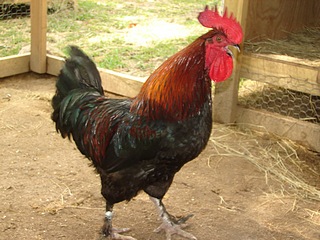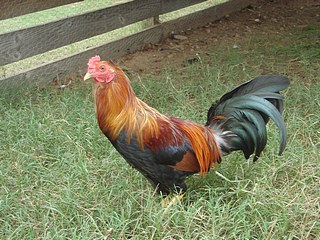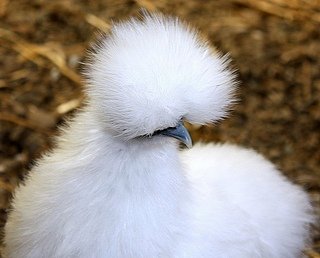Chicken Feathers Questions
Chicken feathers can come in an unlimited variety of colors. Each feather grows with its own blood supply to a predetermined length, width and type, and will systematically be replaced nearly every year or as damaged or lost.
Good feathering is a sign of good healthy but can also mask problems such as sudden weight loss, injury or parasites.
Poor feathering can be a sign of malnutrition, over crowding, parasites, stress, disease, predators, molting or a chicken at the bottom of the pecking order.
Probably the feather’s most important function is helping a chicken maintain a balanced body temperature. Feathers protect from the sun but also create a warmth barrier like a down sleeping bag or comforter.

Feathers can also provide protection from injury and it’s a fortunate chicken that leaves a mouthful of feathers in a would-be attacker’s mouth.
Chicken feathers, all bird feathers are marvels of design and must be maintained daily with hours of self-grooming. Most bird species have an oil gland at the top base of their tail.
With their beak they spread this oil from feather to feather creating a moisture barrier and conditioning each feather. The interlocking barbs that hold a feather’s shape are readjusted and set as needed with gentle systematic preening.
Chickens love to take dust baths. Often they will scratch up the ground, creating loose dirt in a 3 – 6” deep bowl shape, where they will kick up dust, shuffle it with their wings and roll around.
The dust bath can work like a dry shampoo absorbing excess oils from skin and feathers. Some parasites are greatly disturbed by these dust baths and are knocked off or leave.
Chicken feathers vary from breed to breed but an experienced eye can help determine the sex

of developing pullets and cockerels. As with many bird species the adult male chicken or rooster sports a much showier set of feathers.
His neck feathers generally create an exaggerated cape much like the mane of a lion. Towards the end of his back and beginning of his tail saddle feathers they gently drape his flanks and sickle shaped feathers highlight and define his masculine tail in many chicken breeds.
In a straight run (male and female chicks) group, these three feather types will be the first to develop in young males often before they begin to practice crowing or comb development is complete.
The common ancestor of all domestic chickens, the Red Junglefowl, gives us the potential for unlimited variety in chicken feathers colors, sizes and shapes.
This hearty wild chicken gives us a multicolored rooster and drab brownish hen. The roosters very similar in color to what we call BB Red in domestic breeds.
The hen’s drab color and markings help hide herself and her nest as she incubates her eggs and protects her young on the jungle floor. Besides attracting mates, the flashy and colorful rooster can use his feathering to distract predators nearing his hens and young.
His hens instinctively remain on the ground when incubating or rearing young, but both male and female are equipped with enough flight feathering and wing strength to create lift and roost in trees.

Chicken feathers of domesticated breeds often have very similar markings in both male and female, though some breeds mimic the Junglefowl’s camouflaged hen and colorful rooster. Often layer, dual purpose and meat breeds are unable to lift off the ground more than a few feet due to the much heavier muscles and bones bred into them.
Wings and feathers can only do so much for the less aerodynamic domesticated chicken, though visually, feathering is mostly in good proportion to body type and size. But always there are the exceptions…

The Silky is, or should be, void of all barbs that lock feathers together so its feathering looks more like fur. The Frizzle Cochin has been bred to grow feathers that seem to splash here and there from the top of their heads to the bottom of their feathery legs.
These and other chickens with such abnormal feathering, compared to their wild ancestors, may be able to jump down from a few feet but have trouble creating lift with their little wings covered with nothing but soft and fluffy feathers.
The on-set of cooler late summer and fall temperatures alerts us all to the coming winter. In nature and in many domestic species seasonal changes trigger physical changes. Chicken feathers respond with molting.
A chicken will shed many feathers and replace them for the best possible insulation from cold weather. Often hens will cease laying eggs during this time to allow vital nutrients to focus on new feather growth.
If you have questions that you would like to ask a vet, use the service below. Ask a Vet has qualified doctors that can answer questions about chicken health.
Chicken Feathers Questions
.
POLISH HEN NEEDS A HAIR CUT 




Is it OK to trim a Polish hen's crest, so that she might see better? I have 2 Rhode Island Reds, a Plymouth Rock, and the Polish. I've noticed the polish …
BUMPS ON HOCKS 




One of my roosters has raised areas of skin on his hock area. They appear to be swollen or lesions around some of his feather pores. (Not sure what to …
MY DOG PLUCKED FEATHERS 




My dog got ahold of my silkie and plucked some of her back feathers, what can I use on it and will they grow back
WHAT'S UP WITH THIS CHICKEN PICKIN'? 




Our chickens are almost 3 months old. We have 8 that we just recently moved from a large bin in the corner of the garage into a roomy, comfortable coop. …
Do Chickens with Missing Feathers Get Cold? 




i have a plymouth rock that was attacked by an opossum. did not break skin but pulled lots of feathers. its cold weather and was concerned about her …
Boredom & Pecking Order Issues? 




Hello,I have 16 3 week old chicks of various breeds. One of the Australorp chicks has lost all the down from the back of its neck. It still seems to be …
Miscellaneous Chicken Feather Questions 




Question
We have four Black Sex Links, they are beautiful. One of them is losing the feathers on her behind and it looks red. She is walking fine and …
Isa Brown Lost Neck Feathers





Question
Isa Brown lost neck feathers: My Isa Brown (one of 4 pets) has lost neck feathers. I have dipped them in poultry dip for mites but she seems …
Neck feathers missing





Question
Neck feathers missing: My hens have their neck feathers missing. Under their "chins" it is bare to the skin. They are laying well. Any ideas? …
Why does my chicken look plucked?





Question
Why does my chicken look plucked? My hens have been 'cooped' up in their coop for several weeks (the snow has been too deep to let them out). …
Very Bald Chicken





Question:
Very Bald Chicken: I have 14 chickens. They are all really healthy except for one. She is bald underneath, not much of a tail and the feathers …
Chicken Mites Can Cause Feather Loss 




Question
My 15 month old hen has lost neck feathers (all of them) in what seems to be a matter of days.
There are five hens in the coop and she …
Loosing Feathers





Question
How long & how often do chickens molt? They are loosing feathers from their behind area and some from their wing/back area.
They have …
Apparel for Chickens With Feather Picking





Question:
Apparel for Chickens With Feather Picking: I know this sounds strange.
I have a wonderful hen who is having her neck feathers picked out …
Loss of down feathers in domestic chickens
Not rated yet
Question
Loss of down feathers in domestic chickens. I have six chickens in a well-lit clean coop.
During the last three months, four of them have …
Poor Pecked-On Hen & Night Light
Not rated yet
Question
Poor Pecked-On Hen & Night Light : We have a small flock of chickens in a 20 x 20 fenced run with a nice 6 x 6 hen house inside.
They …
Feather loss on tail
Not rated yet
Question
feather loss on tail: I have 22 hens, several different breeds about 1 yr old. Several, not specific to breed, have lost feathers at the base …
Neck feathers are pulled away
Not rated yet
Question:
On the back of one of our Rhode Island Reds, her neck feathers are pulled away from the skin.
There are bloody areas around the outside …
Chicken Molting Not rated yet
Question
Hen losing feathers and walking with a limp. I have a flock of 10 hens, of which 3 of them have started losing their feathers (or molting). …

Custom Search



New! Comments
Have your say about what you just read! Leave me a comment in the box below.